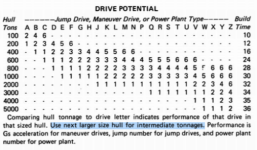There is nothing in the RAW that suggests that a MD is a quantum phenomenon and EVERYTHING else in the LBB2 Performance Table suggests that Drives offer a linear progression of performance in various hull sizes. It is EXPLICIT in the RAW that hulls of intermediate sizes may be created. Now I acknowledge that the RAW, strictly interpreted, state that a Drive C will not produce 2G in any hull. This is a R.A.W. fact.
It's also an example of the
Incompleteness Theorem in action with regards to what the RAW actually contains and spells out (as I've been at pains to bring to light elsewhere).
It's not the that LBB2 Drive Performance Table is WRONG ... but rather that it is INCOMPLETE due to information formatting and publishing limitations of the time it was written (77 and 81).
I am not the judge of your house rules
That might sound reasonable, but LBB2 is very specific on that that is not how LBB2 works
LBB2 (77 and 81) as originally written was very much a "paint by numbers" kind of exercise. There are limited parts and pieces available and you can only use them within incredibly restrictive confines (like the drive performance table that lacks sufficient granularity).
I would say if you want to use LBB2, use LBB2 and accept the tyranny of the Drive Potential Table.
There's a difference between "using the table" and being circumscribed and limited to ONLY the table as written.
It's kind of like pretending that fractions "aren't a thing that can happen" because all the available answers can only be found "in this table" and nothing else counts or matters.
You can SAY that ... but it is incredibly limiting to accept that premise as the be all/end all, discussion over and case closed.
Why?
Because LBB2 was simplified
more than it should have been in order to create the presentation format used in the publication. Once you recognize the formulas "behind the table values" and can do the math for yourself, you realize that the drive performance table is INCOMPLETE rather than ALL ENCOMPASSING as published and presented.
In other words, we can Do Better Now ... because We Are Smart™.
By all means, continue to design ships and post them here, but add "here are my house rules used ..." in a footnote somewhere so the rest of us can see if it might fit into our campaigns.
Let me get this straight.
You need a disclaimer ... on something created and posted on these forums, long after CT's print run has ended ... in order to figure out if that something was created "outside" of the publications for CT (because if it isn't part of the CT print run it cannot be RAW)?
I would have thought such a thing would be self-evident, no disclaimer needed.
I've gotten enough pushback from RAW Purists™ that I now have to
litter my starship designs with citations to RAW on some 30%+ of the line items involved ... and it's STILL NOT GOOD ENOUGH for people who demand RAW Purity Tests for everything. I even include appendices to my starship designs EXPLAINING AND HIGHLIGHTING the "house rules" I'm using to lay out the thinking and methodology involved in extending RAW beyond the mere black letter of what was published ... and it's STILL NOT GOOD ENOUGH for people who demand RAW Purity Tests for everything.
I take the view that RAW is meant to be a resource ... one that can be expanded upon, with new insights and discoveries just waiting to be made ... not a straight-jacket that has ossified into "this and no more" since publication.
Your mileage may vary, of course.



